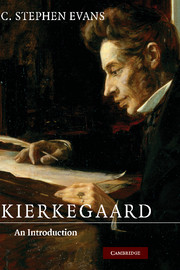Book contents
- Frontmatter
- Contents
- Preface
- Chronology
- Sigla used for Kierkegaard's published writings
- 1 Introduction: Kierkegaard's life and works
- 2 Pseudonymity and indirect communication
- 3 The human self: Truth and subjectivity
- 4 The stages of existence: Forms of the aesthetic life
- 5 The ethical life as the quest for selfhood
- 6 Religious existence: Religiousness A
- 7 Christian existence: Faith and the paradox
- 8 Kierkegaard's dual challenge to the contemporary world
- For further reading: some personal suggestions
- Index
2 - Pseudonymity and indirect communication
Published online by Cambridge University Press: 05 June 2012
- Frontmatter
- Contents
- Preface
- Chronology
- Sigla used for Kierkegaard's published writings
- 1 Introduction: Kierkegaard's life and works
- 2 Pseudonymity and indirect communication
- 3 The human self: Truth and subjectivity
- 4 The stages of existence: Forms of the aesthetic life
- 5 The ethical life as the quest for selfhood
- 6 Religious existence: Religiousness A
- 7 Christian existence: Faith and the paradox
- 8 Kierkegaard's dual challenge to the contemporary world
- For further reading: some personal suggestions
- Index
Summary
Kierkegaard described what he called his “authorship” as beginning with the publication of Either/Or in 1843, although prior to this he had published a little-read and hard to understand critique of Hans Christian Andersen called From the Papers of One Still Living, as well as a very interesting doctoral dissertation, On the Concept of Irony With Continual Reference to Socrates. Most commentators have followed Kierkegaard on this point and have viewed Either/Or as his first real book. However, if one looks at the title page of the original Danish edition of Either/Or, Kierkegaard's name is nowhere to be found. Instead, the name of Victor Eremita (Victor the Hermit) appears as editor, with the two volumes of the work purportedly containing the writings of two other individuals, termed by Victor “A” and “B”, though Victor reveals that B is actually a judge named William. The whole apparatus is made still more complicated by the fact that A's papers include a “Diary of a Seducer,” supposedly written by another man named Johannes, though Victor argues there is good reason to believe that the true author of the Diary is A himself (EO I, 8–9). Volume II, which contains two long letters William has written to A, concludes with a sermon sent to William by yet another character, a country priest.
Either/Or was the first in a large number of such pseudonymous books. Repetition, by Constantine Constantius, and Fear and Trembling, by Johannes de silentio, also appeared in 1843.
Information
- Type
- Chapter
- Information
- KierkegaardAn Introduction, pp. 24 - 45Publisher: Cambridge University PressPrint publication year: 2009
